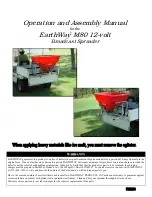To be done before spreading
52
To be done before spreading
Find the correct
settings for the
spreader and set
it accordingly
Avoid contact with the fertiliser and other material
You will most likely get into contact with the fertiliser and other material
you may wish to spread while filling, adjusting and testing the
spreader. Wear protective clothing and gloves, read the safety instruc-
tions provided by the supplier and follow their directions. Contact with
these materials could cause physical harm.
You will find the details for properly adjusting your spreader in the
spreading charts in the spreading charts book and on the website.
→
See also paragraph »Online spreading chart service« on page 56.
The spreading charts indicate what type of fertiliser is best suited to
achieving a good distribution. Correct adjustment depends on the
characteristics of the fertiliser, not the brand! Determine the character-
istics of the fertiliser, therefore, and find the spreading chart with
similar features. Use the chart, even if the brand of the fertiliser differs
from the nearest comparable fertiliser!
Select the spreading chart based on the characteristics of the
fertiliser, not on the basis of the name!
Characteristics of the
fertiliser
The following physical characteristics of the fertiliser have to be
collected before consulting the spreading chart book or the website
•
type and pattern of the granules
→
see the paragraph below,»Determine the type and pattern of
the granules«
•
distribution (= composition of granules of various sizes),
→
see paragraph »Determining distribution« on page 54,
•
similar weight,
→
See paragraph »Determining specific weight« on page 55.
Distribution is the most vital characteristic of the fertiliser when it
comes to spreading. You can make the first selection from the
spreading charts based on the distribution. Never use a spreading
chart for another type of fertiliser, even if the distribution is very similar!
You can determine which spreading chart compares the best to the
fertiliser you are using based on specific weight.
Determine the type and
pattern of the granules
Select the type of fertiliser from the spreading chart that is closest to
the type of fertiliser that you are using.
I
NDICATION
The characteristics of the various types of fertiliser are so far reaching
that using a spreading chart for another type of fertiliser, even if the
distribution is the same, could provide a bad spreading pattern and
could harm the crop!
Содержание RO-C 1400
Страница 4: ...Table of contents 4...
Страница 139: ...Maintenance 139 109 mm Rope Discharge bushing Position V Mechanical...
Страница 153: ...Notes 153 Notes...


















